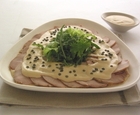|
Italian Entree Braised Veal & Tuna This 200-year old Milanese favorite calls for veal. But pork is delectable—it's also easy on the conscience and the purse. Best to make this a day ahead.
Pork: in a Dutch oven, or any large covered pot, drain tuna oil from can and reserve tuna. Add olive oil to pot and heat till hot (not smoking). Add pork roast and lightly brown. Remove meat. Add onions, carrots, and celery to the tuna-olive oil, cooking till onion is translucent—5-7 minutes. Add garlic and cook, stirring, for 2 more minutes (careful not to burn). Add chicken stock, parsley, bay leaves, thyme, pepper, tuna fish, drained anchovies, and 2 T lemon juice. Bring to a boil, scraping up meat fond from bottom of pot. Return pork to pot, cover, reduce heat, and simmer gently for 3 hours. After 3 hours, remove pork, cool it, wrap it in plastic, and chill it in refrigerator. Sauce: once pork has been removed from pot, turn up heat on tuna-oil-broth mixture in pot. Stir constantly and reduce to about 4 cups. Turn off heat and let cool. Once cool, blend in a food processor, then add the puree to mayonnaise, along with remaining 4 T of lemon juice and capers. Chill. Serving: when ready to serve, slice cold meat, arrange on a platter, cover with half the tuna-mayonnaise, and garnish with lemon slices. Serve the remaining tuna-mayonnaise in a separate bowl. Your guests’ eyes will pop—it is so delicious! * If you want to go the whole hog, so to speak, make your own mayonnaise, by blending (with an electric blender) 2 egg yolks, 3 T of vinegar or lemon juice, pinch of salt and dab of mustard (optional). Then drizzle in 1 cup of oil very, very, very slowly till it emulsifies. Some say not to use olive oil, both due to its difficulty of emulsifying and its overpowering flavor. But that may just be a personal preference. |
Tips & Glossary Arborio Rice: a medium-grained rice. Its high starch content yields a creamy texture and is the basis for risotto. Balsamic Vinegar: dark, thick vinegar with a sweet pungent flavor. Fermented, concentrated, and aged in wooden casks, sometimes up to 12 years. Can be pricey. Caper: salty, pickled bud of spiny shrub native to the Mediterranean region. Most prized is the non-pareil, the smallest (approx. 1/8”), though other sizes are tasty and less expensive. Formaggio: Cheese! Like France, Italy is a land of sublime cheeses, some 400 varieties. Here are some of the most widely sold in the U.S. Italian Seasoning: blend of dried herbs used in Italian cooking—marjoram, thyme, rosemary, savory, sage, oregano, and basil. Packaged commercially and found in most food stores. You can also make your own. Olive Oil: There's much more to know than is room for here. To learn all you need to know about the different grades of oil, and much, much more, head to Tanbourit. Pine Nuts: pinoli or pignoli; edible seeds of pine trees used in pesto sauce. Before cooking, release flavor by lightly browning in a heated skillet. Roasted peppers: buy or make your own: place under a broiler, or hold over a gas flame, till skin chars and blisters. Place in a closed paper bag for 15-20 minutes (to steam them). When cool, the skins slip off under water. Prosciutto: especially Prosciutto di Parma, dry-cured ham from Parma. The real deal! Cured up to 2 years, is almost sweet and very expensive. You can substitute with capicola, a delicious, light peppery ham.
|
Site by BOOM
![]()
LitLovers © 2024

